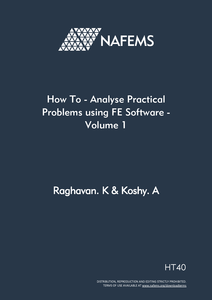
Ever since Turner and associates formulated the constant strain triangle (CST) element, the original finite element, in the year 1956, the finite element method has come on a long way. The tremendous progress is partly due to the enhancements in element technology (isoparametric elements for instance) and progress in solution algorithms and computer technology. There are many books covering the basics [2,3] as well as applications [4]. There are also a host of publications issued by NAFEMS [5,6]. But most importantly there are also many general purpose analysis packages which are ready-to-use and user-friendly. One can mention ABAQUS, ADINA, ALGOR, ANSYS and NASTRAN which are widely used.
As most of these programs have advanced analysis capabilities, the fact of the matter is that there exists a very wide gap between the program capabilities and the knowledge level of the average user, particularly the fresh graduate engineer. This book is an attempt to bridge this gap. The book has six chapters each devoted to a theme.
The chapters are:
a. Choosing the right element type
b. Boundary conditions in non-global directions
c. Rigid regions
d. Simulation of contacts
e. Impact and drop test simulation
f. Cyclic symmetry and axisymmetry
Spread over these chapters, there are eighteen problems of practical importance. By definition, the problems appear to be simple. But they are treated as rigorously as any complex problem would have been. The problems are deliberately chosen to be simple so that the reader can fully understand the physics of the problem and correlate the same with the modelling and analysis options.
Each chapter starts with an introduction to the theme of the chapter. This is followed by a brief description of the theoretical and formulation aspects of the topic. This is followed by two or three case studies that illustrate the concepts involved. All the problems are treated with sufficient detail covering all the important facets of finite element analysis. First and foremost is the choice of element types. Due emphasis is placed on the importance of application of boundary conditions. Through sensitivity analysis, wherever applicable, the criticality of the applied boundary conditions is established.
Due emphasis is also placed on the usage of contacts. In a majority of the engineering situations the load transfer between the adjoining components takes place through contacts. The present day analysis capabilities permit the solution of most of the problems that involve nonlinear contacts. Through several example problems, the importance of contact elements is established.
Contact elements permit a very realistic simulation of the physical behaviour without the need for assumptions with regard to the load path. In the absence of contact elements, a need often arises to make some assumptions with regard to the load path and such assumptions may lead to erroneous results.
Of equal importance is the understanding of the results and making design interpretations. After all, it is expected that any finite element analysis is carried out with the purpose of understanding and improving an existing design or arriving at a new design. With this in view, the significance of the results is described in all the problems.
The primary emphasis, however, is on the physics of the problem and exploitation of the available modelling and analysis options, so that the mathematical model truly reflects the physics of the problem.
Contents
| 1. Introduction |
| 2. Choosing the Right Element Type |
| 3. Boundary Conditions in Non Global Directions |
| 4. Rigid Regions |
| 5. Simulation of Contacts |
| 6. Impact and Drop Test Simulation |
| 7. Cyclic Symmetry and Axisymmetry |
| 8. Conclusion |
| 9. References |



